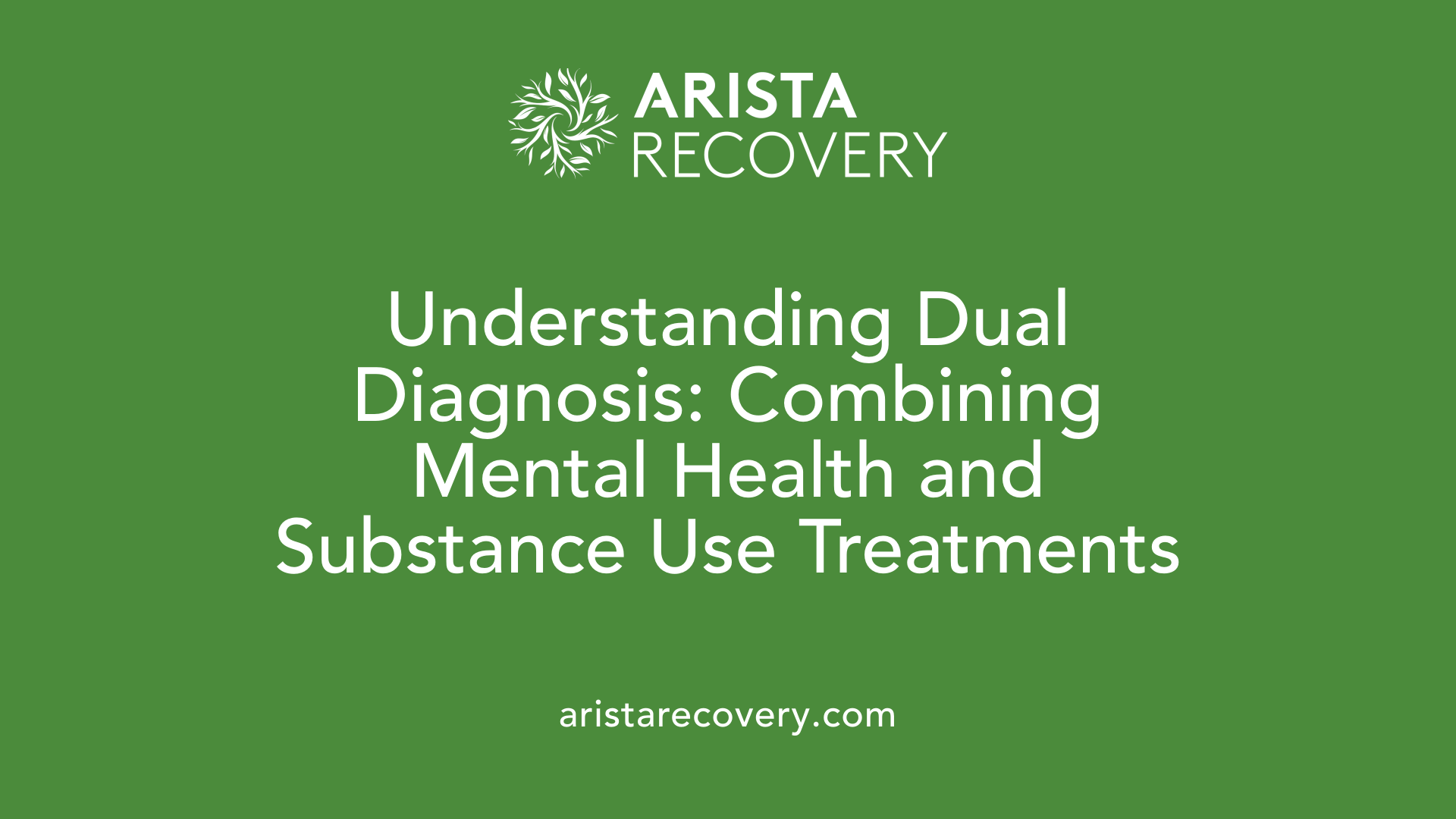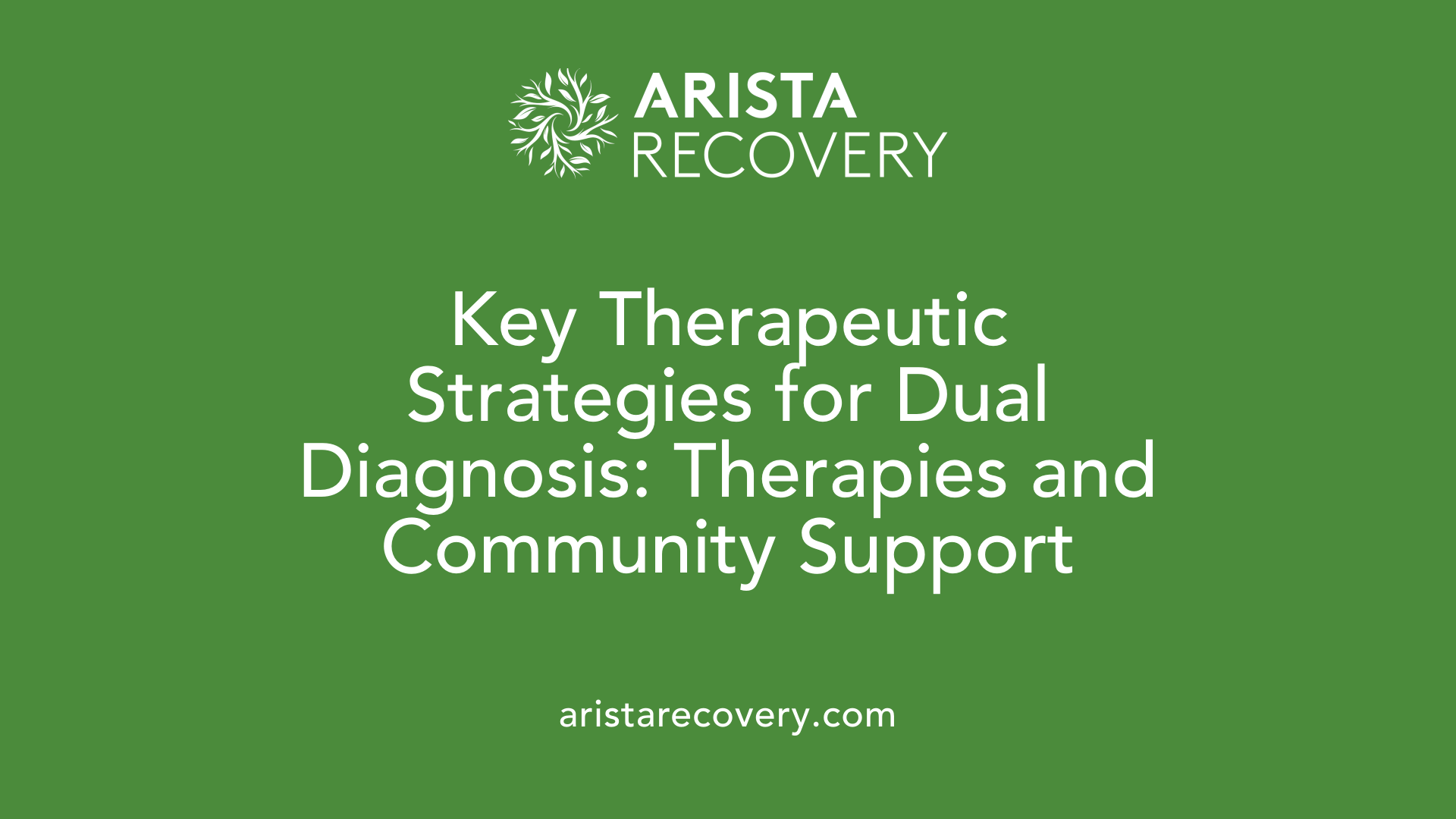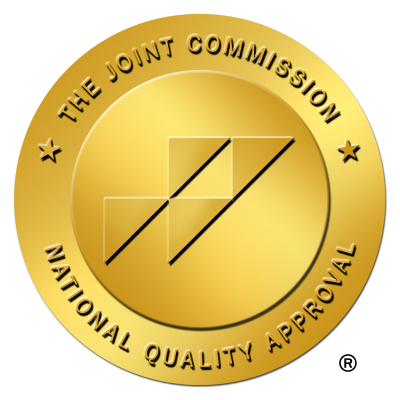How Dual Diagnosis Treatment Addresses Depression and Anxiety

Understanding Dual Diagnosis in Mental Health Treatment
Dual diagnosis involves the coexistence of a mental health disorder and a substance use disorder, occurring simultaneously within an individual. This complex interplay amplifies treatment challenges, requiring a nuanced approach that considers both conditions in tandem. Recognizing the interconnectedness of mental health issues like depression and anxiety with substance abuse, effective treatment strategies focus on comprehensive, integrated care to improve outcomes, reduce relapse, and foster lasting recovery.
Defining Dual Diagnosis: The Coexistence of Disorders

What does dual diagnosis entail in relation to mental health and substance use disorders?
Dual diagnosis refers to the simultaneous presence of a mental health disorder alongside a substance use disorder within a single individual. This coexistence, also known as comorbidity, often results in complex clinical challenges because each condition can influence the severity and progression of the other.
Common mental health issues linked to substance use include depression, anxiety, bipolar disorder, and PTSD. These conditions can lead individuals to self-medicate with alcohol or drugs, aiming to alleviate distressing symptoms. Conversely, substance abuse can cause neurobiological changes that contribute to the development or worsening of mental health disorders.
Effectively managing dual diagnosis involves an integrated treatment plan that addresses both disorders concurrently. This typically includes behavioral therapies such as CBT and DBT, medications to stabilize mood and reduce cravings, and supportive services like counseling and peer support groups.
Recognizing the interconnected nature of these conditions is crucial for successful recovery. Holistic approaches that treat the individual rather than separate issues enhance the likelihood of improved mental health, reduced substance use, and a better overall quality of life.
The Scope of Mental Health and Substance Use Disorders

What does dual diagnosis entail in relation to mental health and substance use disorders?
Dual diagnosis involves having both a mental health disorder and a substance use disorder simultaneously. This co-occurrence is considered a form of comorbidity where both conditions interact and influence each other.
Common mental health issues associated with dual diagnosis include depression, anxiety, bipolar disorder, PTSD, and schizophrenia. These disorders often share risk factors such as genetics, trauma, stress, and early substance exposure.
Individuals with dual diagnosis may self-medicate mental health symptoms with substances, which can worsen their conditions over time. Conversely, substance use can lead to brain changes that foster mental health problems.
Successful treatment of dual diagnosis requires an integrated approach that addresses both conditions at the same time. This generally involves behavioral therapies like Cognitive Behavioral Therapy (CBT) and Dialectical Behavior Therapy (DBT), as well as medications and ongoing support systems.
Holistic and coordinated care not only improves the chances of recovery but also enhances overall quality of life. It’s essential for healthcare providers to recognize dual diagnosis and tailor treatment plans that manage both mental health and substance use issues concurrently.
The Importance of Integrated Treatment Approaches

How do integrated treatment approaches help manage depression and anxiety alongside substance use?
Integrated treatment approaches are essential for effectively managing both mental health conditions such as depression and anxiety, and substance use disorders simultaneously. These methods involve a coordinated, comprehensive care system that addresses all issues in tandem, rather than treating them separately.
A multidisciplinary team forms the backbone of integrated treatment. This team typically includes mental health professionals, addiction specialists, psychiatrists, psychologists, and case managers. Working together, they develop individualized treatment plans that focus on the unique needs of each person.
Key components of these plans include psychotherapy, pharmacotherapy, and behavioral strategies. Evidence-based therapies like cognitive-behavioral therapy (CBT) and dialectical behavior therapy (DBT) are foundational. These therapies help individuals identify and change negative thought patterns, develop healthier coping skills, and manage symptoms more effectively.
Medication management also plays a vital role. Medications such as antidepressants or anti-anxiety drugs can alleviate psychiatric symptoms, while other drugs may help reduce cravings or withdrawal effects related to substance use.
Implementing stage-wise, intensive interventions ensures that treatment addresses the interconnectedness and severity of co-occurring disorders. This comprehensive approach typically results in reduced substance use, stabilization of mental health symptoms, and improved daily functioning.
Overall, integrated treatment enhances the likelihood of achieving lasting recovery. It not only diminishes substance abuse but also significantly improves psychiatric health, overall functioning, and quality of life for those with dual diagnosis.
Core Strategies and Therapeutic Methods
 When it comes to managing dual diagnosis, which involves both mental health conditions like depression and anxiety, as well as substance use disorders, a combination of therapies and community support forms the foundation of effective treatment.
When it comes to managing dual diagnosis, which involves both mental health conditions like depression and anxiety, as well as substance use disorders, a combination of therapies and community support forms the foundation of effective treatment.
Psychotherapy options play a central role in dual diagnosis care. Cognitive Behavioral Therapy (CBT) and Dialectical Behavior Therapy (DBT) are especially prominent. CBT helps individuals recognize and change negative thought patterns that contribute to depression and anxiety, while DBT focuses on emotional regulation and stress tolerance, making it particularly useful for those with mood and impulse control issues.
Medications are another vital aspect of treatment. They are used to reduce symptoms of depression and anxiety, to manage withdrawal symptoms, or to maintain sobriety. Antidepressants, anti-anxiety medications, and mood stabilizers can be prescribed, typically under careful supervision by mental health and addiction specialists. These medications help stabilize mood and diminish cravings, supporting long-term recovery.
Support groups such as Alcoholics Anonymous (AA), Narcotics Anonymous (NA), or specialized community organizations also play an important role. They provide ongoing emotional support, shared experiences, and encouragement to maintain sobriety. Participation in these groups can reduce feelings of isolation and foster a sense of community.
In comprehensive treatment programs, inpatient or residential care settings are often recommended, especially for those with severe substance dependence or complex mental health symptoms. These settings facilitate integrated care, ensuring that therapy, medication, and peer support work together effectively.
By combining evidence-based psychotherapies like CBT and DBT, appropriate medication management, and community support resources, individuals with dual diagnosis can significantly improve their mental health, reduce relapse risks, and enhance their overall quality of life.
Benefits and Outcomes of Dual Diagnosis Treatment

What are the benefits of dual diagnosis treatment for individuals with co-occurring mental health issues?
Dual diagnosis treatment provides a comprehensive approach to managing both mental health disorders and substance use issues at the same time. This integrated care approach is designed to deliver more effective and sustainable recovery outcomes.
One of the main advantages is improved mental health stability. By simultaneously addressing underlying psychiatric conditions such as depression, anxiety, or bipolar disorder alongside substance use, individuals experience fewer symptom flares and better emotional regulation.
Additionally, dual diagnosis treatment significantly reduces the risks of relapse and hospitalization. When both issues are tackled together, patients develop stronger coping skills, which help prevent substance use triggers and manage mental health symptoms more effectively.
Furthermore, this type of treatment enhances overall quality of life and social functioning. Patients often see improvements in their relationships, employment stability, and daily living skills because their treatment addresses the full spectrum of their needs.
Treatment often includes psychotherapy modalities like Cognitive Behavioral Therapy (CBT) and Dialectical Behavior Therapy (DBT), medication management, support groups, and inpatient care when needed. This personalized, multifaceted plan helps individuals learn healthier strategies to deal with stress, cravings, and emotional challenges.
By coordinating care through multidisciplinary teams, dual diagnosis programs also decrease hospital stays and support housing stability. They help avoid medication interactions by carefully tailoring treatments for both conditions.
Overall, the primary benefit of dual diagnosis treatment is rooted in its ability to foster lasting recovery. Patients gain motivation, resilience, and skills necessary for a more balanced and satisfying life, making treatment outcomes more successful and enduring.
Principles and Components of Effective Dual Diagnosis Treatment
What are the principles and essential components of dual diagnosis treatment for depression and anxiety?
Effective dual diagnosis treatment relies on the principle of integrated care, meaning that both mental health disorders—such as depression and anxiety—and substance use issues are treated simultaneously within a coordinated framework. This approach prevents the treatment of one condition from inadvertently worsening the other and promotes a more holistic path to recovery.
At the core, treatment involves a personalized combination of evidence-based psychosocial therapies and medication management. Psychotherapies like cognitive-behavioral therapy (CBT) and dialectical behavior therapy (DBT) help individuals identify and change negative thought patterns, develop healthy coping skills, and manage symptoms effectively. Motivational interviewing and family interventions further support engagement and reinforce recovery efforts.
Medications play a crucial role in alleviating mental health symptoms and reducing cravings associated with substance use. Pharmacotherapy options include antidepressants, anti-anxiety medications, mood stabilizers, and medications like Naltrexone or Suboxone, tailored to each person's needs.
Treatments are delivered by a multidisciplinary team comprising psychiatrists, psychologists, addiction specialists, and social workers who work together through different treatment stages. These stages typically include engagement, stabilization, active treatment, and ongoing care.
Each phase focuses on specific goals: initial assessment and engagement, establishing safety, active therapy and medication management, and finally maintaining recovery through support groups and relapse prevention strategies.
Education about the disorder, skill-building workshops, and community support programs such as Alcoholics Anonymous or Narcotics Anonymous further bolster long-term recovery prospects.
Long-term success depends on individualized treatment plans that address social determinants, such as housing, employment, and social networks, which are vital for sustained recovery. Regular monitoring, relapse prevention planning, and adjusting treatment as needed are integral to achieving positive outcomes.
In summary, the principles of dual diagnosis treatment emphasize an integrated, multidisciplinary, and stage-wise approach that combines evidence-based therapies, medication, and continuous support tailored to each person's unique circumstances.
Addressing the Connection: The Complex Interplay of Mental Health and Substance Abuse
How does dual diagnosis treatment address the connection between mental health conditions and substance abuse?
Dual diagnosis treatment recognizes that mental health issues and substance use disorders are deeply interconnected. This intertwined relationship means that untreated mental health problems can lead to increased substance abuse, and vice versa. To effectively treat both, integrated care is essential, which involves addressing the two conditions simultaneously.
Treatment begins with comprehensive assessments to understand the specific mental health disorder—such as depression, anxiety, bipolar disorder, or PTSD—and the extent of substance use. This evaluation guides the development of a personalized treatment plan that includes multiple therapeutic modalities.
Evidence-based therapies like Cognitive Behavioral Therapy (CBT) and Dialectical Behavior Therapy (DBT) are commonly used. These therapies help individuals recognize negative thought patterns, develop healthier coping skills, and manage symptoms of their mental health conditions and cravings for substances.
Medications can also play a crucial role, with antidepressants, mood stabilizers, anti-anxiety drugs, and medications for substance dependence prescribed under professional supervision. These medications work together to alleviate symptoms, reduce cravings, and prevent withdrawal complications.
Support systems such as peer groups and community resources reinforce recovery efforts. Support groups like Alcoholics Anonymous (AA) or Narcotics Anonymous (NA) provide ongoing emotional encouragement and accountability.
By treating both disorders concurrently, dual diagnosis programs aim to break the vicious cycle—where mental health symptoms trigger substance use, and substance abuse worsens mental health. This integrated approach not only reduces symptoms but also improves overall functioning and long-term stability.
In conclusion, effective dual diagnosis treatment actively recognizes the complex relationship between mental health and substance use, utilizing a coordinated, individualized approach that addresses the root causes, symptoms, and behaviors associated with both conditions. This comprehensive care is vital for achieving lasting recovery and enhancing quality of life.
Holistic Strategies for Lasting Recovery
Effective dual diagnosis treatment employs a comprehensive, integrated approach that recognizes the complex relationship between mental health disorders like depression and anxiety and substance use. By combining evidence-based therapies, medication management, and strong support systems, treatment programs address root causes and interconnected symptoms. This holistic strategy not only manages symptoms but also promotes resilience, relapse prevention, and overall well-being. Tailored interventions that include family, social, and community support systems are crucial for fostering long-term recovery. Addressing both conditions simultaneously improves prognosis, enhances quality of life, and helps individuals build healthier coping skills, ensuring a sustainable path to recovery.
References
- Dual Diagnosis: Definition & Treatment - Cleveland Clinic
- Deal with a Dual Diagnosis: Substance Abuse & Mental Health
- Integrating Treatment for Co-Occurring Mental Health Conditions
- 5 Things to Know About Dual Diagnosis Treatment | Holly Hill Hospital
- Dual Diagnosis vs. Addiction Treatment | Skyland Trail
- Why Pick Dual Diagnosis Treatment for Co-Occurring Disorders
- Dual Diagnosis: An Overview - Lincoln Trail Behavioral Health System
You’re not alone in this.
When mental health challenges and addiction intersect, it can feel isolating. At Arista, we offer compassionate, evidence-based, and trauma-informed care to help you heal, grow, and move forward.
You’re not alone in this.
When mental health challenges and addiction intersect, it can feel isolating. At Arista, we offer compassionate, evidence-based, and trauma-informed care to help you heal, grow, and move forward.
Support that moves with you.
You’ve taken a brave first step. At Arista Recovery, we’re here to help you continue with best-in-class care designed for long-term healing and support.
.webp)






